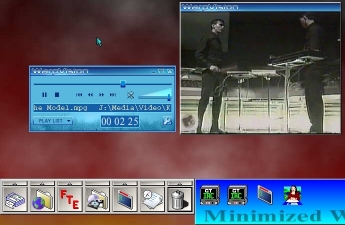
VOICE Home Page: http://www.os2voice.org
[Newsletter Index]
[Previous Page] [Next Page]
[Feature Index]

VOICE Home Page: http://www.os2voice.org |
July 2002
[Newsletter Index]
|
| By Don Eitner © July 2002 |
For your reference, the following video playback tests were performed on my system which is an AMD Athlon 800MHz with 512MB of RAM (PC133), a Matrox Millennium G450 video card, IBM ATA-100 hard drive and a SoundBlaster Live Value for audio. This system is running eComStation 1.0 (with fixpack 2 applied), Scitech Display Doctor SE 7.0.9 (the limited version of SDD available through the ecomstation.com website or through IBM's Device Driver Pak Online) and the SBLive driver version 0.81.
 Pictured
at left is a screen capture of part of my eComStation desktop showing the WVGUI
player for OS/2 with its default skin. It is playing the deleted Spider-Man movie
trailer. This is an MPEG video (MPEG-1 as far as I can tell) and it plays flawlessly
under WVGUI on my system, including the audio track. It's certainly a refreshing
change from IBM's OpenMPEG player (available in the Netscape 4 PluginPak) which
has always being CPU intensive on my system and drops frames. WVGUI appeared to
handle playback with no noticeable skips or dropped frames and the rest of my system
remained usable throughout playback.
Pictured
at left is a screen capture of part of my eComStation desktop showing the WVGUI
player for OS/2 with its default skin. It is playing the deleted Spider-Man movie
trailer. This is an MPEG video (MPEG-1 as far as I can tell) and it plays flawlessly
under WVGUI on my system, including the audio track. It's certainly a refreshing
change from IBM's OpenMPEG player (available in the Netscape 4 PluginPak) which
has always being CPU intensive on my system and drops frames. WVGUI appeared to
handle playback with no noticeable skips or dropped frames and the rest of my system
remained usable throughout playback.
 At right we see
another screen capture showing WVGUI running another MPEG video, this one by the
German band Kraftwerk. This video also played with no noticeable problems. My intent
here was to test something intensive with video and audio syncing, but this particular
video, as it turns out, shows no lip movement by the singer. I would say that everything
played on queue but there really is no way to determine that with this video. It
was pleasant to finally be able to watch it under eComStation, though.
At right we see
another screen capture showing WVGUI running another MPEG video, this one by the
German band Kraftwerk. This video also played with no noticeable problems. My intent
here was to test something intensive with video and audio syncing, but this particular
video, as it turns out, shows no lip movement by the singer. I would say that everything
played on queue but there really is no way to determine that with this video. It
was pleasant to finally be able to watch it under eComStation, though.
 In this
final test I wanted to try an AVI file encoded with the popular DivX 4 codec. I
also wanted to test WVGUI's full-screen playback capabilities. Unlike the previous
two test videos, this one, from the US version of the television comedy show "Whose
Line is it Anyway", requires much more synchronization between the video and
the audio in order to be effective. I did notice a slight delay in the video, but
it was less than one second behind the audio throughout the 20+ minute play time.
If the camera was not right on the person speaking you would not be able to tell
that anything was wrong. It was just the up-close shots that showed some lipsyncing
problems. The blockiness of the display is in the video itself -- the full screen
playback was done at 1024x768 resolution, far higher than the resolution of any
television broadcast. Also, DivX encoding is designed to merge similarly colored
pixels that are next to each other in order to reduce file size.
In this
final test I wanted to try an AVI file encoded with the popular DivX 4 codec. I
also wanted to test WVGUI's full-screen playback capabilities. Unlike the previous
two test videos, this one, from the US version of the television comedy show "Whose
Line is it Anyway", requires much more synchronization between the video and
the audio in order to be effective. I did notice a slight delay in the video, but
it was less than one second behind the audio throughout the 20+ minute play time.
If the camera was not right on the person speaking you would not be able to tell
that anything was wrong. It was just the up-close shots that showed some lipsyncing
problems. The blockiness of the display is in the video itself -- the full screen
playback was done at 1024x768 resolution, far higher than the resolution of any
television broadcast. Also, DivX encoding is designed to merge similarly colored
pixels that are next to each other in order to reduce file size.
Changing between full screen and windowed display modes was quick and painless,
though it required a double click on the right mouse button where I am used
to double clicking with the left button for such things in other OS/2 programs.
MPEG video is nothing new. Even MPEG-2 (the format used for commercial DVD videos) is not new, but also has not been entirely supported under OS/2 before. WVGUI, which is based upon the source code of WarpVision (a command-line program) claims to support both MPEG-1 and MPEG-2 video streams. I was not able to test the MPEG-2 claim as I do not have any videos which I know to be in the MPEG-2 format and also do not have a DVD-ROM drive in my PC.
WVGUI also supports the very popular DivX file format, versions 3, 4 and 5. I have tested with videos in all three formats and verified that they do work, with both video and audio playback.
The last major claim to fame here is that WVGUI supports Micro$oft's ASF video codec, which if I am not mistaken is what Micro$oft calls MPEG-4. It's an older version of the Windows Media format so its appearance here was unexpected. I tested with two video files which I know to be in this so-called MP4 format. One of them worked very well but without audio and the other, which had no audio to begin with, displayed only very colorful gibberish in the display window. But one out of two proves that it is not impossible to get Windows Media support under OS/2 and eComStation, it will just take a bit more work to get it right. The real problem is that M$ of course keep changing their formats to keep the competition off balance in trying to support them. Windows Media 8, for instance, is not the same as ASF which is not the same as Windows Media 7.
WVGUI has many features, all easily accessible through a notebook interface. On the main WVGUI program, just click the icon of a wrench in the lower-right corner to access this notebook. You can, for example, disable audio or select the audio device to use, if you have multiple soundcards in your PC. You can resample audio up to 48KHz or downsample from 48 to 44.1KHz (CD quality). Video decode options include decoding to RGB16 or RGB24 (16 or 24 bits per pixel) or using the popular YUV422 color space. Using the YUV422 setting should probably only be done if you have installed the recent HWendive support driver on your system.
You can choose to maintain the video's aspect ratio (4:3, 16:9, etc) when resizing the display window or with this option disabled you may stretch the display window any way you wish. It's your choice. You can have WVGUI automatically switch to full-screen display when playing a video or you can have the normal (non-full-screen) display window float on top of other desktop windows.
You may also change the program's system priority through the settings notebook, allowing you to optimize its performance for maximum quality or maximum system multitasking. My tests were performed using the default priority settings.
WVGUI also supports skins (much as WarpMedia, reviewed here earlier this year, and WinAMP do) though only one skin is provided with the program so I was not able to test any others.
According to the documentation which came with WVGUI, the playlist function is not yet implemented. Indeed, when I would try to open the playlist and add more than one video to the list, the program would crash. However playing one video at a time, manually loading each one after the previous video had ended, worked without any problems for my three test videos.
When using the option to maintain the video's aspect ratio when resizing the display window, any attempt to resize said window resulted in a program crash. This did not occur when this option was disabled and a bug report has been filed with the developer. I am told this one has already been fixed for the next release.
Some video formats which WarpVision does not understand either did not play right (in some AVI files which were neither DivX nor ASF format I could hear the audio but saw no video) or crashed WVGUI outright. Since the filename .AVI is truly meaningless (there are probably two dozen incompatible video codecs which commonly use the same filename extension) this can be a hit or miss problem for many users. It would be best if WVGUI could trap the error and display a message stating that the file format is unknown, and simply go no further in trying to load it.
And lastly, I was not able to successfully use the HwEnDIVE support driver. I installed it per the instructions that came with the driver and rebooted my system. Removing the driver's entries from CONFIG.SYS and rebooted resolved the problem. After that, any attempt to play any video in WVGUI resulted in a program crash. This is also being reported to the developer since the documentation indicates that this setup (WVGUI + HwEnDIVE + Matrox G450 graphics card) was extensively tested.
For modern day video playback under a modern day operating system like eComStation or OS/2, there is probably no better solution than WVGUI. It has some flaws, but to be fair Alex Samorukov, the program's developer, does claim that it is not yet finished, but as a native OS/2 program with support for some formerly Windows-only video files, it is a huge step in the right direction. I no longer need an old DOS program (QuickView Pro) for viewing MPEG and DivX videos and now I get sound support which was lacking in my DOS sessions due to no DOS drivers for the SoundBlaster Live cards. It is a free program, so there is really no reason to not try it out for yourself.
References:
|
Don Eitner is the developer of The 13th Floor website http://freiheit.syntheticdimension.net
[Feature Index]
editor@os2voice.org
[Previous Page] [Newsletter Index] [Next Page]
VOICE Home Page: http://www.os2voice.org